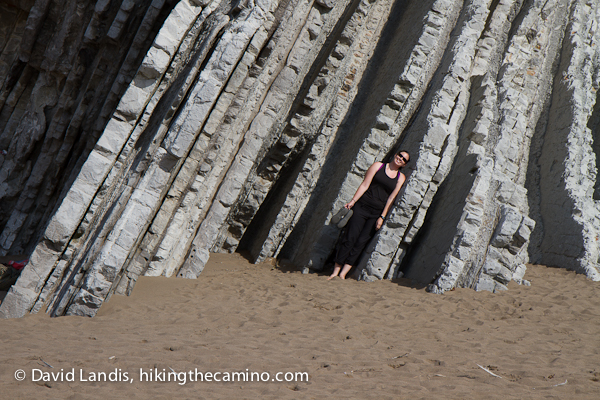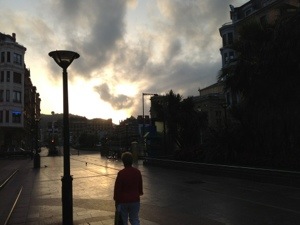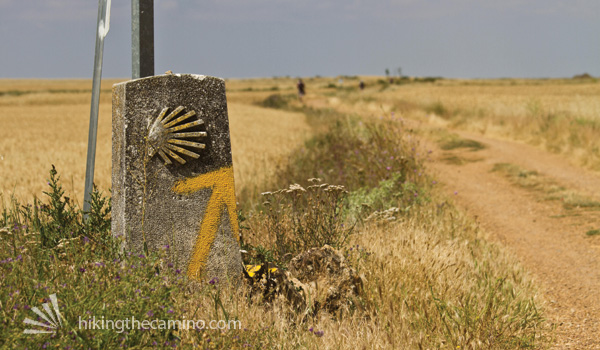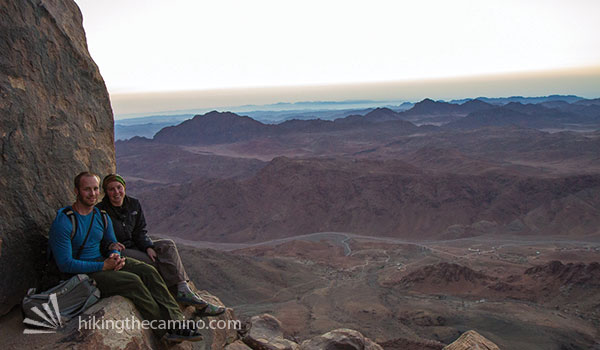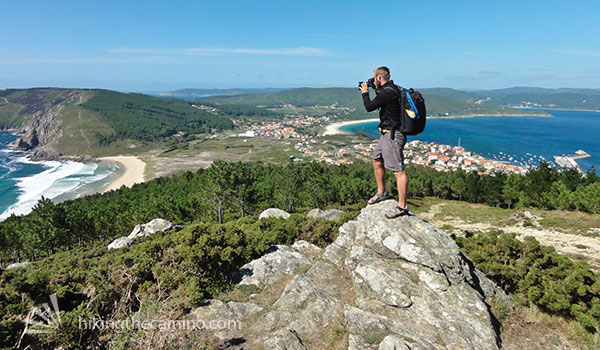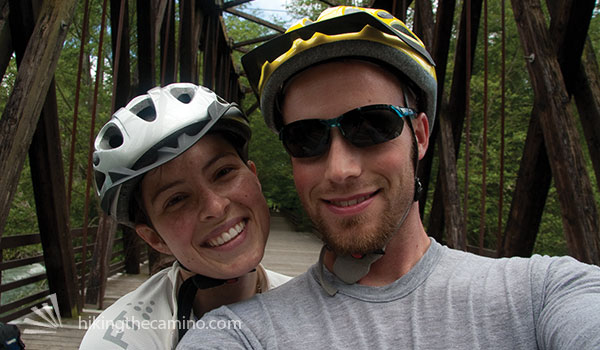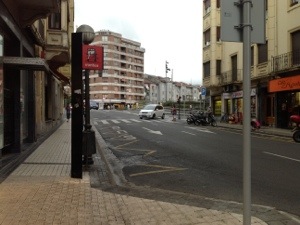
We arrived safely in Hendaye, France last night after a tight train connection from Paris Beauvais airport. Other than a bit of running in the train station, all the connections went very smoothly. We enjoyed our 5.5 hours on the high-speed train which gave us a chance to rest, read and prepare ourselves.
Our arrival at 11pm in Hendaye left us with a bit of a dilemma. The pilgrim albergue in neighboring Irún closed at 10pm, so there was no option to sleep there. Usually in this situation we would seek out an inexpensive pensión (simple guesthouse), often we can get a double room for around €25. However, since this area is a tourist beach destination and August is the height of high season, all the hotels and guesthouses in the area were about double their normal prices, with the cheapest hotels starting at €60. Even the French gite, a dormitory similar to an albergue, was over €20 each (so about $50 for the two of us to sleep in dorms).
We decided to take a chance and save some money by stealth camping. We consulted Google Maps satellite view and determined that there were a lot of green areas within 2km of the city. We also noted a cemetery on the outskirts of towns near what looked like forests and fields. We decided to walk to this area and see if we could find a suitable place to sleep in “el aire libre” (the outdoors).
We were in luck, as there was a small green hill across from the cemetery which afforded us a sheltered spot to sleep. The cemetery also had a water spigot which we were able to use to fill our water bottles and rinse off our faces, and even had a small sheltered area with bathrooms!
Stealth camping can be a fun adventure and is a nice option when albergues are full or accommodations expensive. It’s important to find a good place that is unobtrusive. If you arrive after dark and leave before sun-up in a hidden place, most likely no one will ever know you were there. It can be helpful to ask locals for advice for a good place to camp. When we have done this, we have sometimes been invited to camp in someone’s yard or sleep in their house! When stealth camping is very important to leave no trace, and definitely not to leave any trash, toilet paper, etc. We have found that people are generally positive toward stealth campers if the campers are considerate. Be sure to respect any posted signs that say “no camping” and avoid any delicate environments that can be damaged by camping impact.
So this morning we woke up in our stealth campsite outside of Hendaye. We walked back to the train station for an eye-opening coffee (which we were shocked to find cost €3 each! About twice the usual price). Then we made our way to Irún to explore the points of interest and find our way around town. We decided to spend this whole day in Irún in order to fully explore the city and its neighboring city of Hondarribia. The pilgrim albergue in Irún doesn’t open until 4pm, but we stopped by to see it and there was a cleaning lady working who allowed us to drop off our heavy packs for easier exploration.
We really enjoyed visiting the sites of Irún and the beautiful Old City of Hondarribia. We had a picnic lunch in the grass outside of the fancy Parador of Hodarribia. Anna took the bus out to the sports shop Decathlon to get some fuel for our camp stove while Dave caught up on some emails at a cafe. At 4pm we checked into the Irún albergue, which is quite a sweet place. The hospitalero checking us in was very kind and helpful. He told us to pick any bed in any room (there are 30 beds in 6 rooms). We felt very excited to find one small room with only 2 beds in it! It is almost like having a private room except that there is no door, so we will likely still hear any snoring going on in the neighboring rooms. Did I mention that this lovely, clean albergue with its great showers does not charge any fee? They just request a donation of whatever you are able to give. We normally give €5 a person (the average cost of a simple albergue) and more for albergues that we really enjoy, that treat us very kindly or offer extra services like meals (this albergue does provide breakfast).
After checking in, we took showers. The showers at the Irún albergue are GREAT! Good water pressure, super hot water, and good privacy. After showers, we washed our sweaty hiking clothes and walked across the street to the grocery store (Super BM is the actual name of the store!!) We prepared a simple, filling meal of pasta with lentils, mushrooms, red pepper and tomato sauce. We were also excited to be reacquainted with the delicious and dirt cheap wines of Spain. We had a tasty Navarran tempranillo for all of €1.49.
It feels great to be getting back into the pilgrim rhythm. We are still working out the kinks of our packing and learning how to keep the most important items handy in our packs. We generally like to pack light, but we do need more equipment when we are doing research for guidebooks, such as our Macbook Air, two SLR cameras, some backup hard drives, two GPSes, and a slew of chargers, batteries, etc. We are also packed to be able to camp, so have our lightweight Tarptent and sleeping pads in addition to our usual sleeping bags. We acquire weight along the way as we collect city maps, brochures and other info that helps us with our research. Occasionally we stop at a post office and mail these items ahead to ourselves so we don’t have to carry them the whole way.
Our plan for tomorrow is to walk to San Sebastián (about 30km, with two alternate routes which we will walk separately). There is an intermediate accommodation at Pasaia San Juan which we may stop at if we need more time. We will keep you posted as we get started walking!
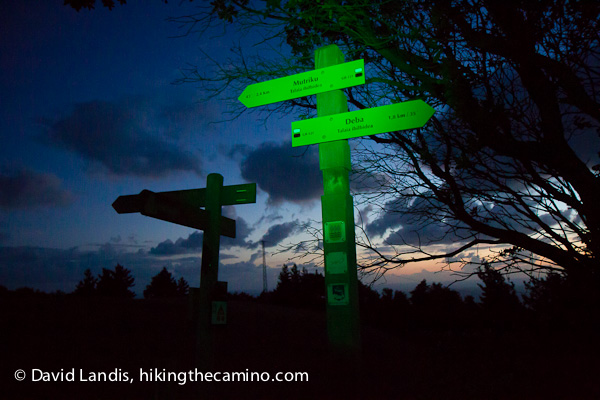



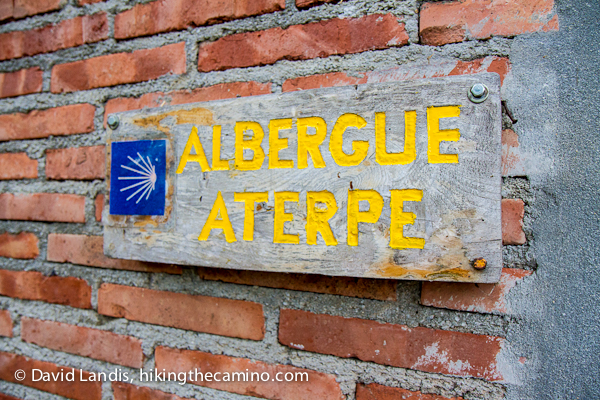
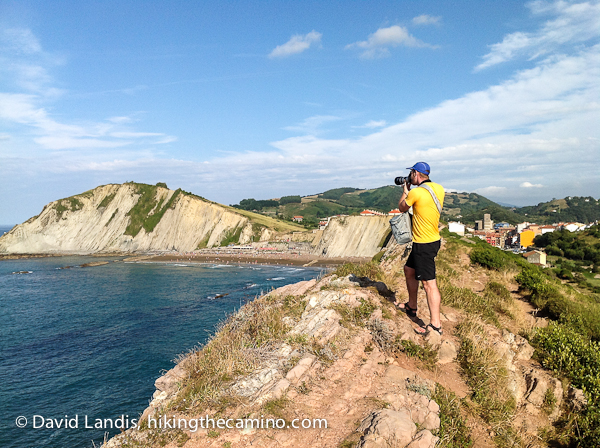
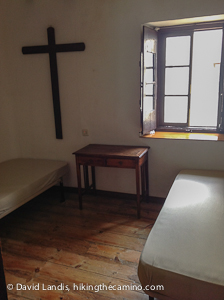 Many of the albergues in Basque country are only open in July and August so we are lucky to be here just in time to enjoy them. Otherwise, often the only option is a youth hostel, which are rather pricy at €20+ per person, and can be loud and crowded.
Many of the albergues in Basque country are only open in July and August so we are lucky to be here just in time to enjoy them. Otherwise, often the only option is a youth hostel, which are rather pricy at €20+ per person, and can be loud and crowded.